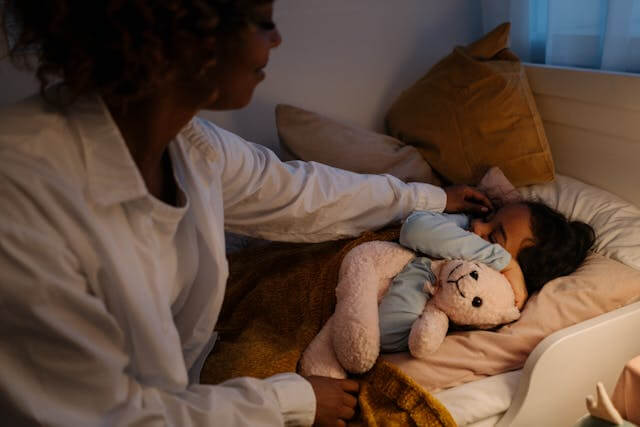Are you tired of nighttime bedwetting accidents? You’ve tried everything – limiting drinks, reward charts, midnight wake-ups – but the bed is still wet?
What if the real reason for bedwetting lies in retained primitive reflexes from infancy that are supposed to integrate into the central nervous system (i.e., disappear)? A retained reflex could be the missing link you have been looking for.
For many families facing childhood bedwetting, the usual explanations like small bladder capacity or deep sleep don’t tell the entire story; one often-overlooked factor, retained primitive reflexes, could be silently impacting your child’s bladder control.
WHAT ARE PRIMITIVE REFLEXES?
Primitive reflexes are the automatic movement patterns that occur in newborns. These reflexes are crucial for survival and early development of your child. Examples of reflexes you may have heard of are the “rooting reflex” when your baby is hungry or the “grasp reflex” when your baby’s hand grips your finger tightly. As a child’s brain matures, these reflexes are typically integrated, becoming controlled by higher brain systems (the central nervous system), and eventually disappear. Unless, of course, they don’t disappear and become a retained reflex.
If these reflexes persist beyond infancy, they can interfere with various developmental processes, including the neurological control needed for nighttime bladder control.
COULD A RETAINED REFLEX BE CONTRIBUTING TO YOUR CHILD’S BEDWETTING?
Let’s explore potential connections:
1. The “Gentle Touch = Wet Bed” Phenomenon (Spinal Galant Reflex)
Imagine a light touch on your child’s lower back, like the pressure of bedsheets. In infants, this triggers a hip and spine movement. If the Spinal Galant Reflex remains active, this gentle stimulation can trigger involuntary bladder contractions during sleep ([1, 2]).
- Look for fidgeting a lot while your child is sitting or lower back ticklishness.
2. The “Startle Response = Nighttime Accident?” Link (Moro Reflex)
The Moro Reflex, the infant’s startle reaction to sudden stimuli, involves extending and retracting the arms and legs. A retained Moro Reflex can potentially lead to a heightened state of arousal and anxiety, possibly disrupting sleep patterns and interfering with the neurological signals for bladder control ([2, 3]).
- Look for over-sensitivity to sensory input or whether or not your child can be easily startled.
3. The “Head Position = Bladder Issues?” Connection (Tonic Labyrinthine Reflex – TLR)
The Tonic Labyrinthine Reflex (TLR) links head position to muscle tone throughout the body. Head tilting forward encourages limb flexion while tilting it backward encourages extension. A persistent TLR can contribute to poor posture and muscle imbalances, potentially affecting the ability to fully relax and maintain bladder control at night ([2, 4]).
- Look for noticeable posture issues or coordination difficulties.
WHAT DOES THIS MEAN FOR YOU?
Bedwetting is not always the simple issue of bladder development. A retained primitive reflex could indicate an underlying neurological factor you can address with your child’s pediatrician, chiropractor, or an occupational therapist.
WHAT CAN YOU DO ABOUT BEDWETTING?
While more extensive research is needed, approaches that focus on integrating these reflexes through specific movements and activities are under continual exploration ([5]).
Consider doing the following:
- Seek professional advice: An Occupational Therapist or a developmental specialist experienced in assessing and addressing retained primitive reflexes can offer great advice. They can provide a personalized evaluation as well as recommendations.
- Explore Integration Exercises: Specific, gentle movements can help the brain integrate these reflexes. There are many great resources with exercises to help integrate retained reflexes online. You can start at this great website. A few exercise examples include:
- “Snow Angles” and “Sit Walks” for the Spinal Galant Reflex
- “Starfish” exercise and Deep Pressure acitivites for the Moro Reflex
- “Superman(woman) Pose” and “Fetal Position” for the TLR
- Remember to be Patient and Consistent: Integration can take some time. Keep it fun, and consider also doing these exercises with your child.
This often-overlooked connection can be the hidden solution for your child’s bedwetting. If you find this information helpful or know someone struggling with a bedwetting child, please share this article to help them on their nighttime dry-sleep journey.
References and additional information:
- Zaidi, Z. S., & Mayo, N. E. (2018). Chiropractic interventions for the treatment of nocturnal enuresis in children: A systematic review. Journal of Chiropractic Medicine, 17(4), 246–253. https://doi.org/10.1016/j.jcm.2018.07.006
- Goddard Blythe, S. (2009). “The Well Balanced Child: Movement and Early Learning.” Hawthorn Press.
- Schmitt, B. D. (2004). Nocturnal enuresis: An update on a common childhood problem. Pediatric Clinics of North America, 51(3), 637–658. https://doi.org/10.1016/j.pcl.2004.01.004
- Ayres, A. J. (1972). Sensory integration and learning disorders. Western Psychological Services.
- Hannaford, C. (2005). “Smart moves: Why learning is not all in your head“ Great Ocean Publishers.
- https://drlaurenbaker.com/blog/primitive-reflexes Discover tests to check for retained reflexes and various exercises to integrate them on this website.
You can also search online for additional terms like Occupational Therapy, Sensory Processing Disorder (SPD), and Primitive or Postural Reflexes. Additionally, we also have some information on the primitive and postural reflexes in this article and within our member’s area.
Disclaimer: This information is for informational purposes only and should not be considered medical advice. Please consult your child’s pediatrician before deciding about your child’s health.
Cover image by Cottonbro Studio

